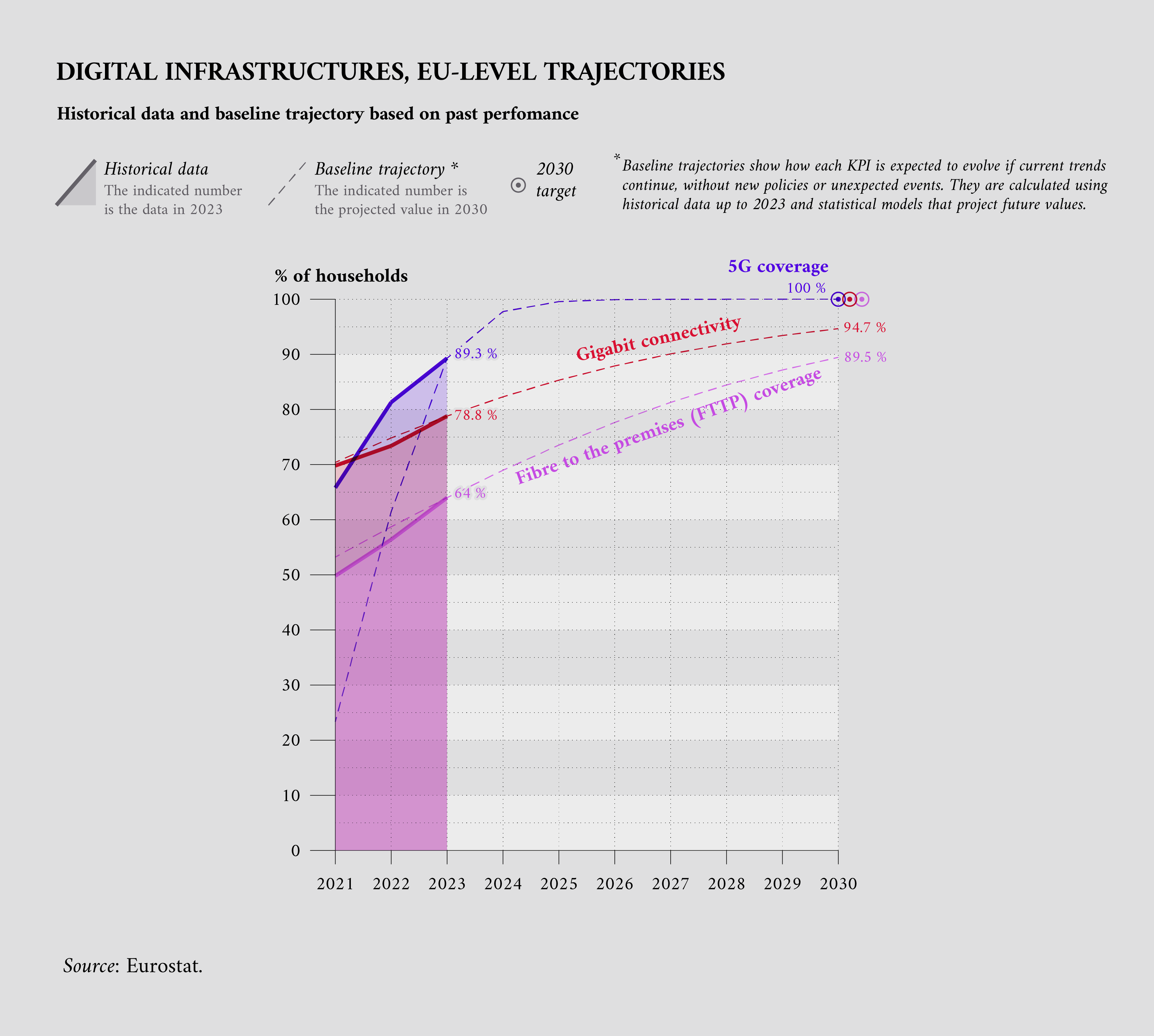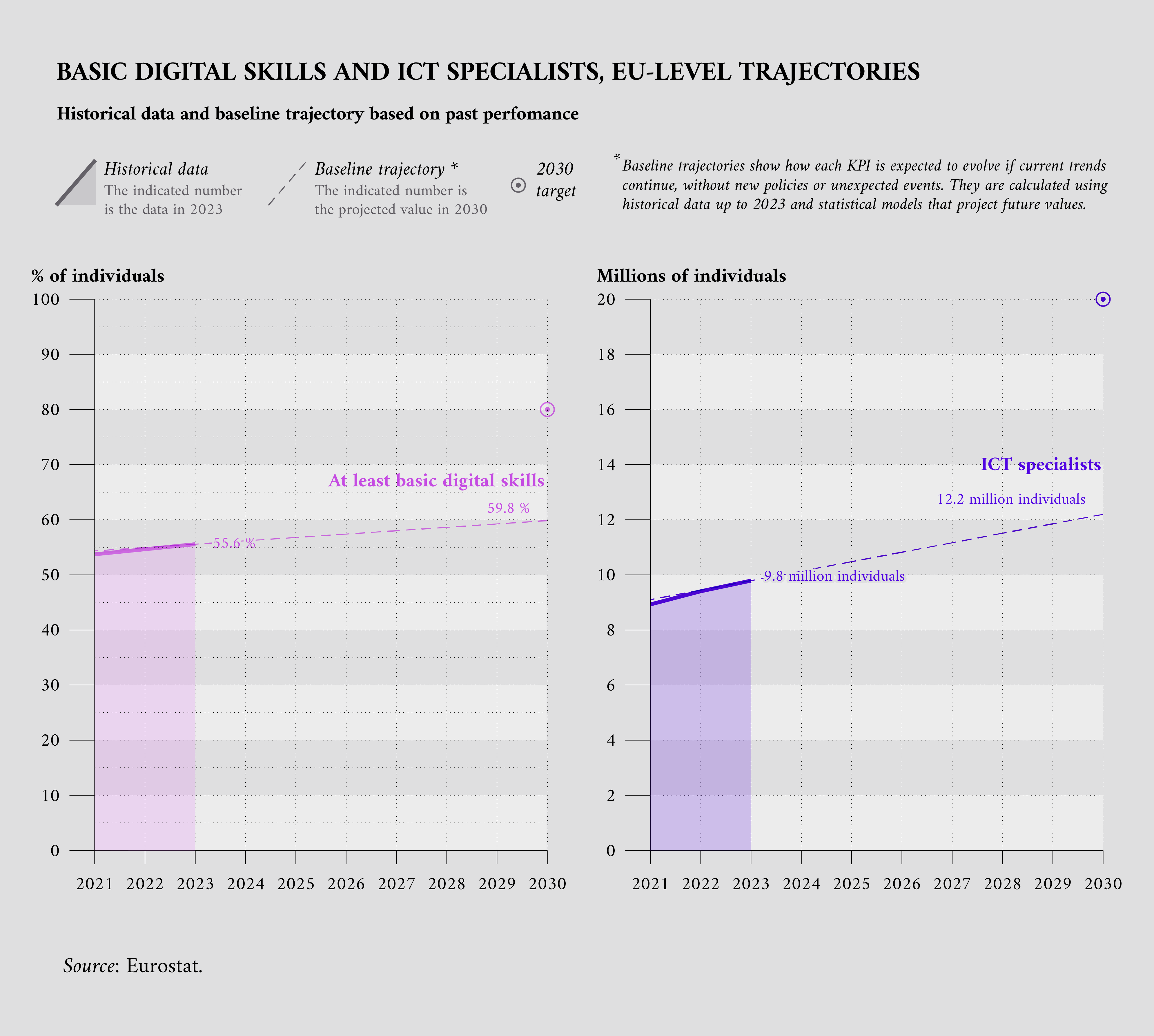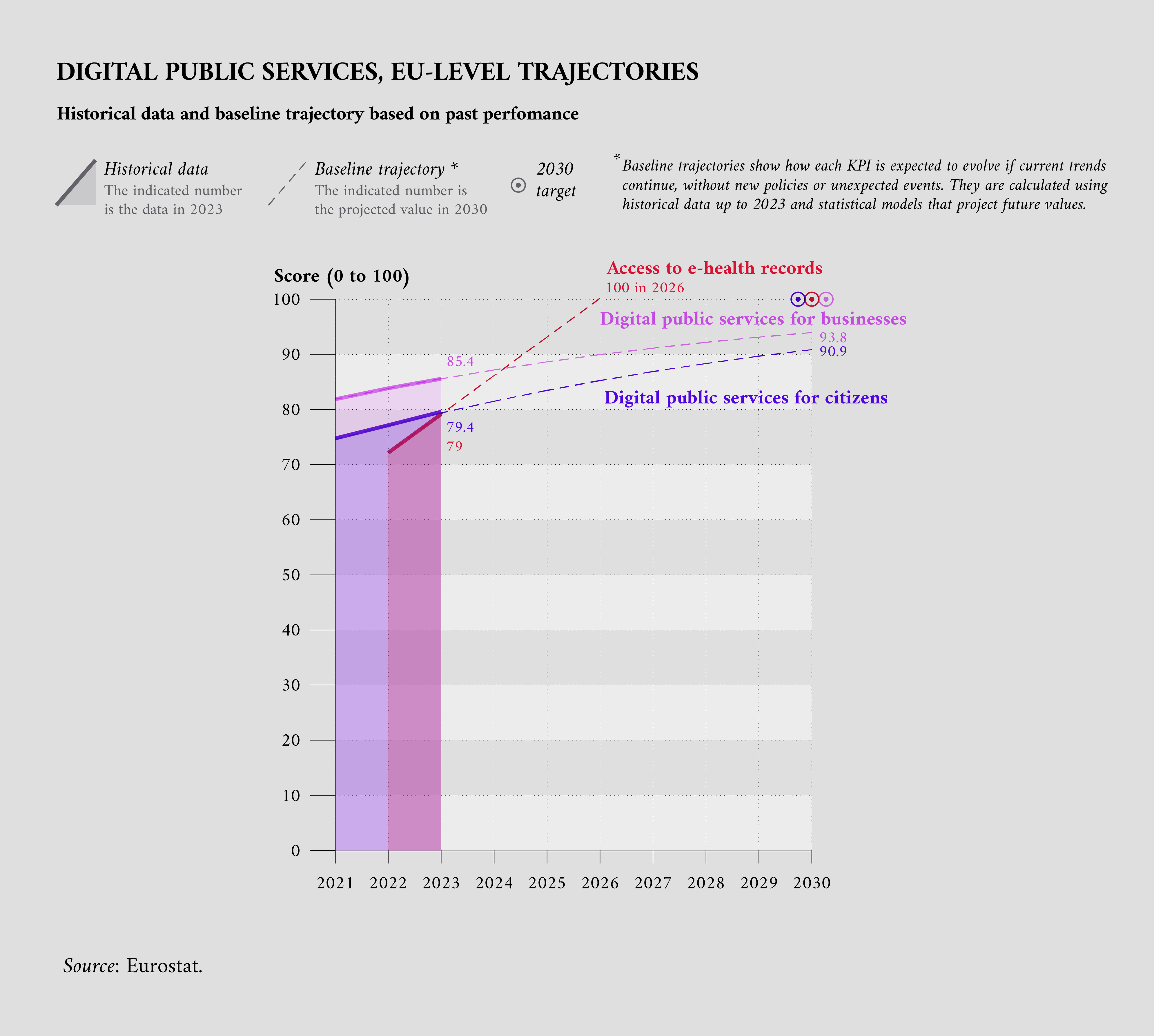Delivering the Digital Decade: Are we on track?
A progress check on digital infrastructure, skills and e-government targets
From remote villages gaining 5G coverage to seniors navigating e-health portals, Europe’s digital transformation is reshaping how people live, work and access public services.
In 2021, the EU launched the Digital Decade policy programme to secure digital sovereignty by 2030, built on four key pillars. With 2025 marking the programme’s midpoint, this data story takes the opportunity to assess the programme’s progress. Drawing on the latest available open EU datasets, it explores progress on three of the four pillars of the Digital Decade:
- digital infrastructure – measured through connectivity indicators such as 5G and broadband;
- digital skills – a prerequisite for meaningful participation in the digital age;
- digital public services – citizen-facing services, also referred to as e-government.
As this story mostly focuses on citizen-centric outcomes, the fourth pillar of the Digital Decade, business digitalisation, is not covered.
Is digital infrastructure ready?
Fast, reliable internet is a prerequisite for a society in which every citizen can fully participate. Recognising this, the Digital Decade programme set several targets under the digital infrastructure pillar. This story focuses on three key performance indicators (KPIs) within this pillar that have high societal impact.
- Gigabit connectivity for all households by 2030, meaning ultra-fast internet with download speeds of at least 1 gigabit per second, enough to support streaming, remote work and connected devices all at once.
- FTTP (fibre to the premises) coverage, a key broadband technology enabling such high-speed gigabit connections by bringing fibre-optic cables directly to homes.
- 5G coverage in all populated areas, measured as the percentage of towns and built-up regions within EU Member States that are covered by at least one 5G network, providing high-speed mobile internet for smartphones and future digital services.

Figure 1: 2023 scores and 2030 projections for gigabit connectivity, FTTP and 5G coverage KPIs of the Digital Decade policy programme (Source: Eurostat/data.europa.eu)
As displayed in Figure 1, all three indicators show strong upward trends, with 5G coverage leading the way. As of 2023, 5G coverage had reached 89.3 % of populated areas, putting it well on track to achieve full coverage by 2030, and most probably earlier. Gigabit connectivity stood at 78.8 % of households and is projected to grow to 94.7 % by 2030, which is close to, but still below, the 100 % target. FTTP coverage saw a notable 7.6 percentage point increase in just one year, rising from 56.4 % in 2022 to 64 % in 2023. Despite this rapid growth, it remains the most limited indicator. Projections show it will reach 89.5 % by 2030, which leaves the biggest gap from the target compared to the other two KPIs.
Staying on course for the 2030 target may depend on continued investment in digital infrastructure. Expanding FTTP coverage is especially critical, not just as a technical upgrade but as a means to ensure equal access across regions. A faster rollout of fibre connections can help rural communities benefit from the digital transformation and lessen the urban–rural divide.
Do Europeans have the digital skills to thrive?
Access means little without the skills to use digital tools effectively. Digital literacy is essential for accessing services, participating in civic life, finding employment and pursuing lifelong learning. Open data plays a key role in tracking progress towards these goals by showing where digital skills are growing and where more support is needed.

Figure 2: 2023 scores and 2030 projections for the KPIs in digital skills and ICT specialists of the Digital Decade policy programme (Sources: Eurostat/data.europa.eu, Eurostat/data.europa.eu)
A main KPI of the Digital Decade policy programme is for 80 % of individuals aged 16 to 74 to have basic digital skills (i.e. the ability to find information, communicate, create simple content, stay safe online and solve basic technical problems) by 2030. Figure 2 illustrates that, as of 2023, only 55.6 % meet this benchmark, nearly 25 percentage points below the target. In addition, baseline projections, which assume that current trends will continue without new policy interventions, indicate the gap from the target will remain more than 20 percentage points by 2030, risking digital exclusion for many.
Alongside basic skills, the EU also aims to cultivate a workforce with specialised digital competencies. This KPI calls for at least 20 million ICT specialists (i.e. professionals who develop, operate and maintain ICT systems) employed across the EU by 2030. As of the 2023 data collection, only 9.8 million individuals in the EU are employed in these roles, with projections estimating 12.2 million by 2030 if current trends persist.
While there is some progress, both KPIs remain far off target. In particular, the slow progress in basic digital skills risks excluding a significant portion of the population from essential services and job opportunities. These trends highlight a growing need for investment in digital skills, which is also an opportunity to strengthen the EU’s global competitiveness.
Are digital public services keeping up?
Citizens interact with the government daily through services like tax filing or accessing social benefits. To support the digital transition, the EU has defined targets aimed at making these services available online efficiently and to a high standard, ensuring they are user-friendly, secure and inclusive.

Figure 3: 2023 scores and 2030 projections for the KPIs in digital public services for citizens, digital public services for businesses and access to e-health records (Sources: European Commission, Publications Office of the European Union)
Under the Digital Decade plan, the EU aims for 100 % online availability of key public services for citizens and businesses by 2030. This is measured by two respective KPIs, which assess the share of administrative steps that can be fully completed online for specific life events. While some life events are unlikely to achieve full online completion (for example, getting married will still require in-person steps), the goal is to ensure that all feasible digital steps are available online (not that the entire process happens online). As shown in Figure 3, digital public services for businesses outperformed those for citizens in 2023 (85.4 versus 79.4 points, respectively). Both are projected to fall short of the 100-point target by 2030, with business services expected to reach 93.8 and citizen services expected to be 90.9. Although the gap is closing, citizen-facing services still lag behind business services. Ensuring that citizen services also reach full digital accessibility by 2030 remains a key priority.
Another relevant KPI is for all EU citizens to have access to their electronic health records by 2030. This KPI reached 79 points in 2023 and is on track to meet its 2030 target well ahead of schedule, indicating rapid progress.
Overall, digital public services are becoming more mature across the EU, advancing faster than other pillars of the Digital Decade. However, further progress is increasingly complex, and reducing disparities between Member States will be key to meeting 2030 targets.
Conclusion
At the halfway point of the Digital Decade, Europe’s digital transformation is measurable – and open data is making that progress visible. By tracking selected indicators, this story highlights where momentum is strong and where critical gaps remain.
Digital infrastructure and digital public services are advancing steadily, laying the foundation for a more inclusive digital society. For instance, access to electronic health records is on track to meet its target ahead of schedule. On the other hand, digital skills remain the biggest bottleneck, threatening to undermine gains in infrastructure and services. Without equipping individuals to use these tools, the digital transformation will be incomplete.
To stay on track for 2030, targeted investment and policy focus must close the widest gaps. The good news? These findings are drawn from open datasets and studies that anyone can access, meaning Europe’s digital transition is not only measurable but also a shared responsibility. By openly assessing each pillar’s progress, stakeholders at all levels can identify where to act and ensure the 2030 vision is achieved.
